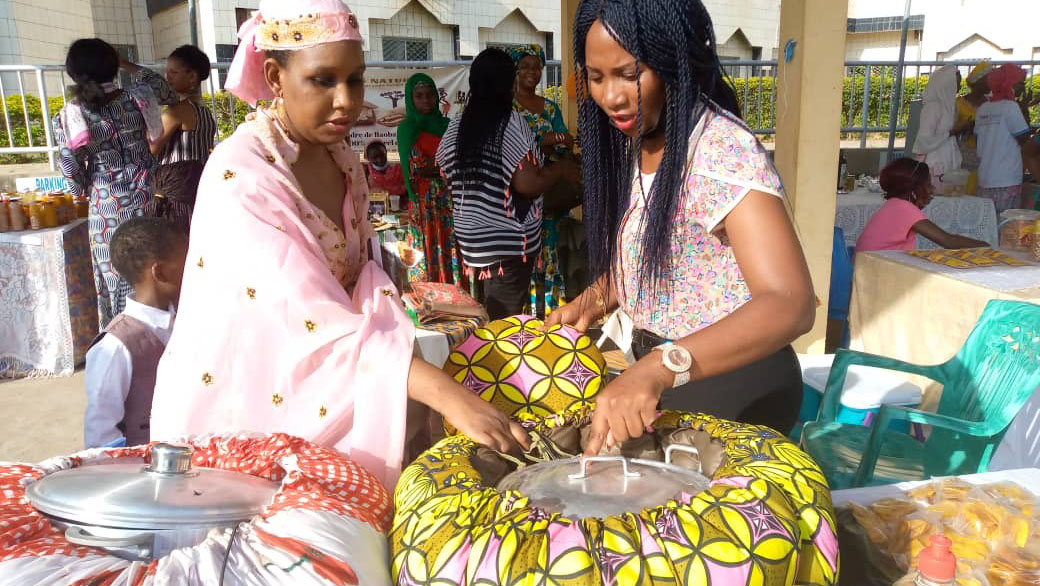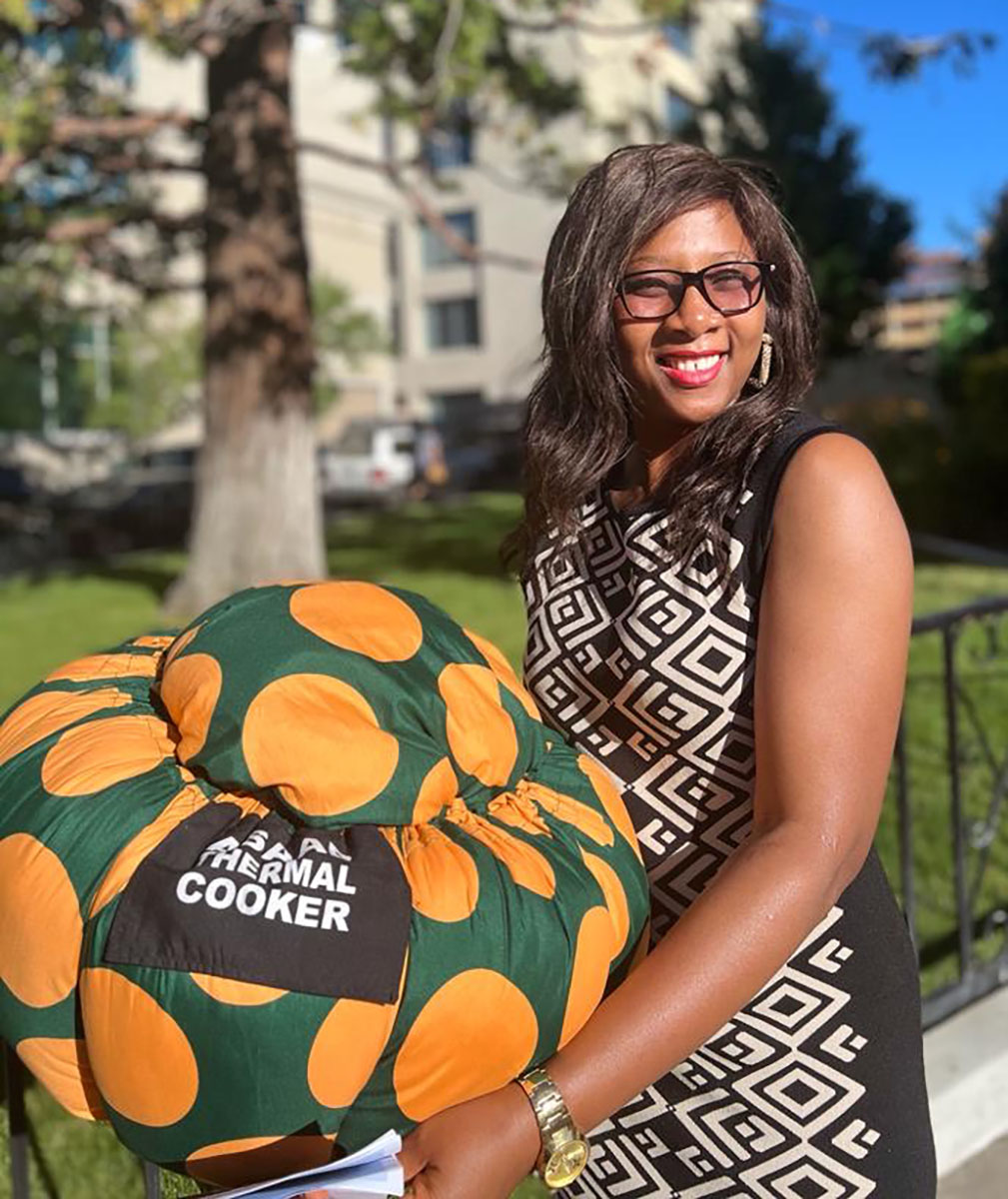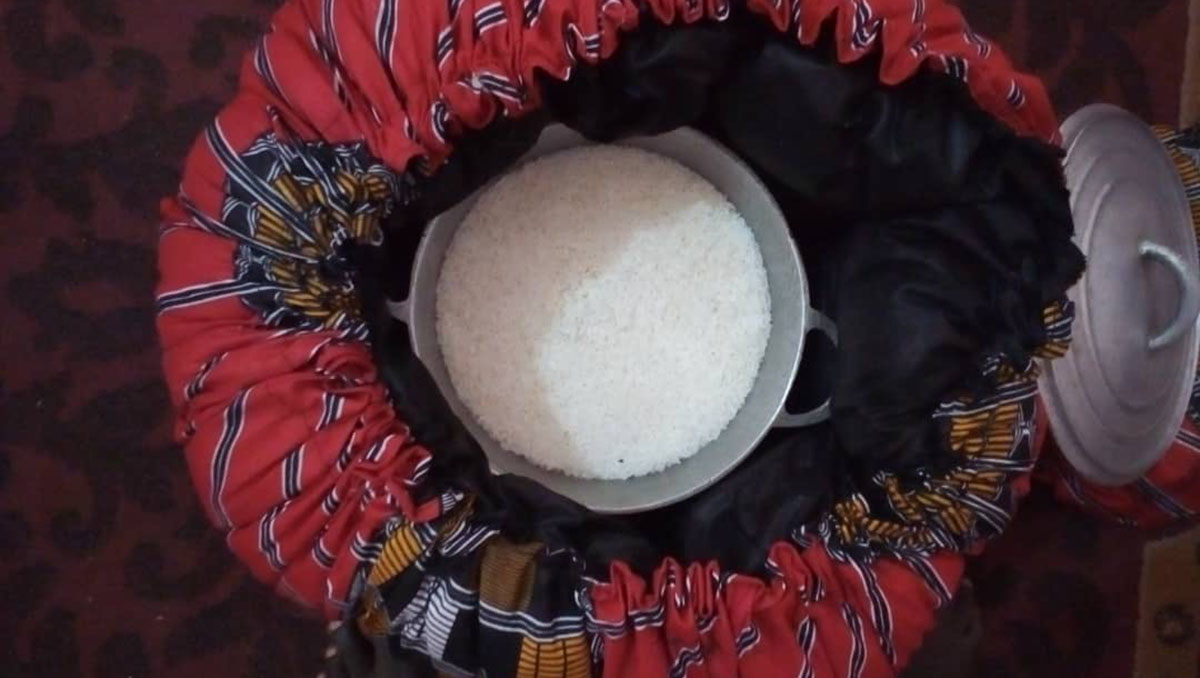
Aisata Ibamie, right, a young renewable energy engineer and innovative clean energy activist from Cameroon, demonstrates how her ASAAB Thermal Cooker is used. (Photo courtesy Aisata Ibamie)

Aisata Ibamie, right, a young renewable energy engineer and innovative clean energy activist from Cameroon, demonstrates how her ASAAB Thermal Cooker is used. (Photo courtesy Aisata Ibamie)
FULL TRANSCRIPT:
From unclean air hovering over cities to unhealthy smoke in homes, air pollution continues to put human health and climate on the line. Cameroon, popularly referred to as Africa in miniature, is reputed for its geographical and cultural diversity, especially when it comes to traditional meals. For most Cameroonians, the three stone fireside method of cooking transcends just making food. It speaks to generational cultures and bonds built over moonlight folklore and folktales of their shared history.
But, for the longest time, the process of preparing these meals has been largely powered by biomass fuels, made possible by the cutting down of trees. The health challenges associated with exposure to these cooking methods cannot be undermined as about 3.2 million worldwide deaths in 2020 were attributed to household air pollution, according to the World Health Organization. Despite these health consequences, most people across sub-Saharan Africa still cannot afford clean cooking technologies.

Aisata Ibamie is a young renewable energy engineer, innovative clean energy activist, and a Mandela Washington Fellow (MWF) from Logone, a Charey village in the Far North Region of Cameroon, and she has had first-hand experience with the challenges of cooking in the country. (In full disclosure, MWF is where this author first met Ibamie.) Growing up in a rural community, fetching firewood for cooking was one of her least favorite chores –– a routine she shares with more than 70% of Cameroonians who still do not have access to clean cooking technologies, as revealed by the World Bank.
Driven by curiosity, Ibamie’s rare passion and determination to change this narrative for Cameroonians led to her creation of an energy efficient and affordable cooker: a cordless, portable, and non-electric bag made from cotton. Ibamie hopes the ASAAB Thermal Cooker will go a long way to reduce deforestation and carbon dioxide emissions.
“If I want to cook red beans for example, it often takes us two to three hours with firewood or gas. With the thermal cooker, you need just 15 minutes of gas or firewood to boil it, take it off and place in the ASAAB Thermal Cooker and close. After 3 hours, it is ready. Rice is just 25 minutes on the cooker after heating on any classical fire for 3 minutes. You can leave the food in the cooker for up to 10 hours and it will still be hot when you get back. Our customers testify that they are preparing red beans, meat, and others. This is a way for the woman to be free. We have natural and artificial carbon footprints. Using the ASAAB Thermal Cooker reduces CO2.”
The tragic and avoidable chronic illnesses from unhealthy cookstoves continue to put women and girls at the most vulnerable positions as they often stand at the frontline of gathering fuels and preparing meals. To Ibamie, providing the thermal cooker solution will not only save lives and the climate, but go a long way to address gender inequalities and promote girl child education in Cameroon.
“One of the motivations for the ASAAB Thermal Cooker is that I come from the Far North Region of Cameroon, where women are often marginalized. So they don’t really go to school as they are are expected to take care of the family and not supposed to be educated in school. Every time they are cooking — for up to three times per day. Always cooking, so they don’t have to go anywhere because they are controlling food. For me, it was a way to give them a chance to take care of the family and also go to school, do business, or go on vacation if they want to. In fact, to be free of always going to the kitchen every time.”
A recent research publication in the Pan African Medical Journal found that indoor pollution already kills about 7,000 people in Cameroon annually. Considering the numerous kitchen accidents recorded from cooking appliances, Ibamie designed the ASAAB Thermal Cooker with user-safety in mind.
“I was thinking about safety. I wanted something light that customers would not need too much (experience) to use. The ASAAB Thermal Cooker is very safe to use as you don’t have to plug into current or put in the sun before using. It is very simple to use. Even your children can come back from school, open it, and serve themselves easily — unlike gas, where you maybe worried that they are exposed to fire, which is very dangerous for the household.”
As the number of internally displaced women and girls continue to rise in Cameroon due to security concerns such as the ongoing Anglophone Crisis in the Northwest and Southwest Regions, and the Boko Haram insurgency in the Northern regions of the country, Ibamie believes the thermal cooker could not be more timely.

“The cooker is a blessing for displaced women because they are never stable. They are always moving from one place to another, so it is easy to handle. It is very light. It is less than three kilograms (approximately 6.5 pounds) and you can pack it in a handbag and you go anywhere you want to go with. I can say it is very practical.”
As an emerging young African leader, participating in the 2022 Mandela Washington Fellowship at the University of Reno, Nevada, served as an opportunity to scale her business by expanding to new markets.
“I met Fellows that I can work together with, in the same areas like cooking and climate change and thermal energy efficiency. So yes, I really met people and made customers who brought me other customers, so I have to ship ASAAB Thermal Cookers to the U.S.”
By helping to reduce the cutting of trees, Ibamie is contributing to one of the focal points of the United Nations Environmental Program (UNEP), which is to achieve a significant reduction in deforestation while boosting agricultural productivity. It also aligns nicely with one of the resolutions of the Climate Pact during the 26th edition of the United Nations Conference of Parties in Glasgow (COP26 Glasgow Climate Pact), which hammered on the protection, conservation, and restoration of natural ecosystems such as forests.
According to Project Drawdown, if global adoption of clean cookstoves grows to 16% by 2050, 15.8 gigatons of carbon dioxide emissions will be reduced. As the world prepares to unite for the 27th U.N. conference in Egypt to reflect on the progress with pledges and commitments to accelerate global actions in the climate fight, Ibamie hopes that access to clean cooking will give climate delegates food for thought.
—
[EDITOR’S NOTE: This transcript was edited for clarity.]